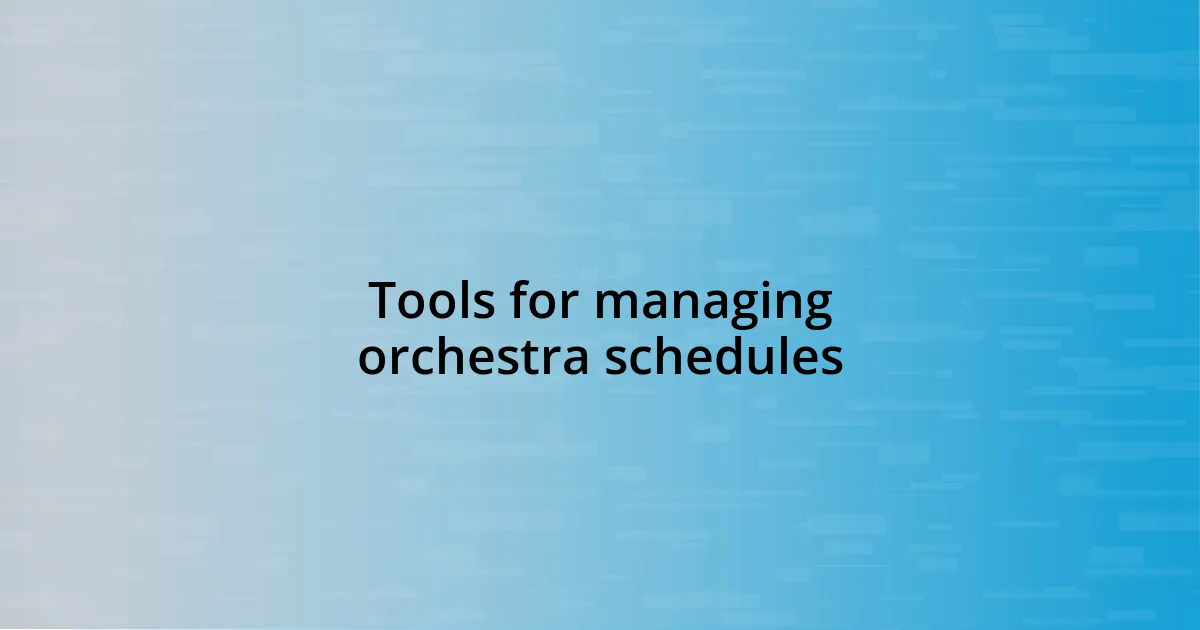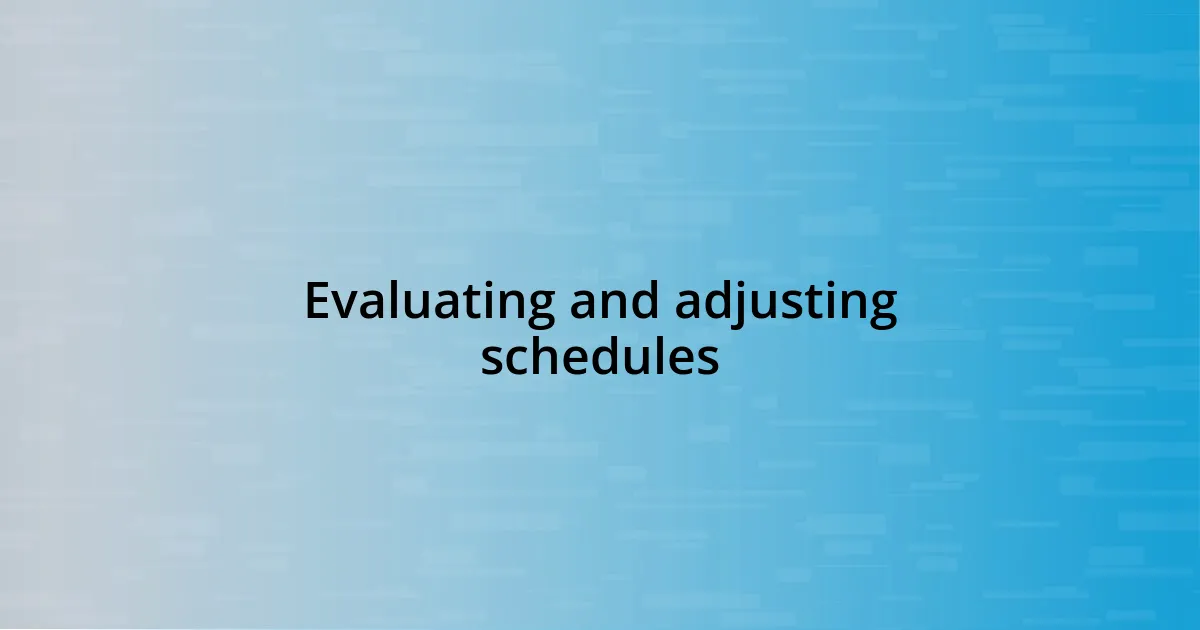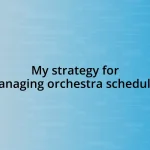Key takeaways:
- Understanding the individual commitments of musicians is crucial for effective orchestra scheduling, requiring empathy and flexibility.
- Clear communication, advanced planning, and active musician input foster collaboration and a supportive atmosphere within the ensemble.
- Utilizing a mix of digital tools and traditional methods ensures efficient schedule management and enhances community engagement.
- Regularly evaluating and adjusting schedules based on feedback leads to improved attendance and overall satisfaction among musicians.

Understanding orchestra scheduling needs
Understanding the scheduling needs of an orchestra can feel like piecing together a complex jigsaw puzzle. From my experience, each member, whether it’s a string player or a percussionist, has unique commitments that can clash with rehearsal or performance times. Don’t you find it fascinating how one missed rehearsal can ripple through everyone’s plans?
Moreover, the emotional connection musicians have with the music significantly influences scheduling dynamics. I remember a particular instance when a soloist’s emotional attachment to a piece led them to insist on specific rehearsal dates that aligned with their personal reflections on the work. It made me realize scheduling is not just about logistics; it’s about respecting individual journeys.
Timing is everything in orchestra management. I’ve learned the hard way that flexibility is crucial when unexpected events pop up—like a sudden illness or family emergency. How do we maintain harmony without stretching everyone too thin? Balancing the schedule requires empathy and understanding of each musician’s world, allowing them to perform at their best while fostering a supportive environment.

Key factors for effective scheduling
When it comes to effective scheduling, I’ve found that clear communication is essential. Often, musicians juggle multiple commitments outside of the orchestra, so providing them with a detailed schedule well in advance makes a world of difference. I recall a time when I sent out a tentative rehearsal calendar months ahead; the feedback was overwhelmingly positive! Musicians felt their input was valued, and that created a sense of ownership and responsibility among the ensemble.
Here are some key factors to consider for effective scheduling:
- Advance Planning: Share rehearsal dates early to allow for personal commitments.
- Flexibility: Be ready to adapt; last-minute changes are inevitable.
- Musician Input: Encourage feedback from the orchestra members, which fosters collaboration.
- Balance: Ensure that rehearsal times accommodate everything from long work hours to family obligations.
- Prioritization: Identify which pieces require more rehearsal time based on their complexity and emotional weight.
I’ve learned that taking these factors into account doesn’t just streamline the scheduling process; it also nurtures a supportive atmosphere. Ultimately, these considerations not only help in managing schedules but also reinforce the bond within the orchestra, enhancing overall performance.

Tools for managing orchestra schedules
In my journey of managing orchestra schedules, I’ve come to rely on a mix of digital and traditional tools. For instance, I’ve found that platforms like Google Calendar are invaluable for their ease of sharing and accessibility. I still vividly recall a time when I grouped our orchestra on a shared calendar—suddenly, everyone was on the same page, and attendance improved dramatically. How often do we overlook the value of simple, efficient communication?
Another tool I’ve embraced is scheduling software specifically designed for musicians like those from “Orchestra Manager.” This software offers features tailored to our needs, such as tracking instrumental sections and individual availability. I remember the excitement when we first utilized this system; it felt like we had upgraded from a flip phone to a smartphone! It’s amazing how a specialized platform can streamline our efforts and free up more time for creativity.
On a different note, traditional methods still hold their ground. A whiteboard in the rehearsal space or printed schedules handed out post-rehearsal can foster a sense of community. I’ll always cherish those moments of musicians gathering around that board, discussing their plans and highlighting dates collectively. It fosters camaraderie and ensures everyone feels invested in our shared timeline.
| Tool Type | Benefits |
|---|---|
| Google Calendar | Shared access, real-time updates, easy integration with devices |
| Orchestra Management Software | Specifically designed features for scheduling and availability tracking |
| Physical Whiteboards | Promotes community engagement, visual reminder for commitments |

Strategies for conflict resolution
Navigating conflicts, especially in an orchestra setting, is both a challenge and an opportunity for growth. I recall a particular rehearsal where tensions flared over scheduling discrepancies. Instead of letting emotions dictate the moment, I facilitated a discussion where everyone would share their concerns. This open dialogue not only diffused the situation but also allowed us to collaboratively adjust the schedule, leading to a more harmonious environment. Can you imagine how much smoother practices can be when everyone feels heard?
In my experience, adopting a proactive mindset when addressing conflicts is crucial. Establishing ground rules for communication early on—like giving everyone a moment to express their thoughts—has proven effective. I remember implementing a simple “raise your hand to speak” rule during our meetings, which instantly improved focus and respect among orchestra members.
Another effective strategy is empathy; understanding the pressures your musicians face enables you to address conflicts from a place of compassion. For instance, I once had a violinist who was struggling to balance family obligations and rehearsal times. By approaching her with empathy and discussing options, we found a solution that honored her commitments while also keeping our rehearsal schedule intact. Isn’t it fascinating how a little understanding can turn potential conflicts into collaborative problem-solving?

Communicating with orchestra members
When it comes to communicating with orchestra members, I’ve found that clarity is paramount. I once implemented a practice of sending out a weekly email that summarized upcoming events and important notes. The response was overwhelmingly positive. Musicians appreciated this touchpoint, ensuring everyone remained informed and connected to our collective goals.
I also believe that one-on-one conversations can work wonders. During a particularly busy season, I took time to check in with each musician individually. One flutist shared that she was feeling overwhelmed, and by discussing her availability openly, we adjusted her rehearsal schedule. It was a relief to see her light up, and it reinforced the importance of making space for those personal dialogues in our busy schedules.
Utilizing group messaging platforms has transformed our communication dynamics as well. I remember introducing a dedicated chat channel for quick updates and reminders. It not only provided a space for real-time communication but also helped cultivate a sense of community. The variety of emojis and inside jokes that emerged within those chats reminded me how we are not just a group of musicians— we’re a family navigating the beautiful chaos of making music together. Isn’t it incredible how a simple message can fill a room with warmth?

Evaluating and adjusting schedules
Evaluating and adjusting schedules isn’t just about logistics; it’s about understanding the people involved. There’s a time during our season when we reached that critical juncture. I remember a late rehearsal where attendance numbers dipped. After a quick pulse check, I discovered that many musicians had personal commitments bubbling up. By discussing these conflicts openly in our next meeting, we not only reshuffled rehearsal times but also prioritized flexibility, which resulted in revitalized energy during practices.
As I sifted through the importance of scheduling, I realized the value of feedback loops. After each major performance, I send out a short survey asking how the schedule worked for everyone. It’s like taking the orchestra’s temperature. One year, a percussionist mentioned he had trouble balancing rehearsal with his teaching schedule. Acting on this, we adjusted some evening rehearsals—his gratitude was palpable! When musicians feel their voices matter, it strengthens our bond and improves the overall atmosphere.
Reflecting on our successes reminds me of a key moment when adjusting our schedule led to greater satisfaction. We were preparing for a concert, and I noticed one busy week had back-to-back practices with little downtime. I suggested a mid-week break and heard a collective sigh of relief. Imagine how much better performances can be when musicians aren’t just physically present but also mentally recharged. This experience reinforced my belief that we’re not just managing schedules—we’re crafting a shared experience that respects the needs of each individual.

Best practices for long-term planning
Long-term planning in orchestra scheduling is all about foresight and adaptability. I’ve found that setting a detailed calendar well in advance is crucial. For instance, when I planned our season six months ahead, it allowed musicians to share their availability without the stress of last-minute changes. I still recall the relief on their faces when they realized they could make travel plans or family commitments without any conflict. Isn’t it empowering to take the uncertainty out of their schedules?
Another best practice I’ve learned is to build a flexible framework that can accommodate unexpected changes. One time, after scheduling a major concert, our lead violinist faced a personal issue that rendered her unavailable. Instead of scrambling, we discussed backup plans during our next meeting, ultimately designating alternate musicians who were excited to step in. This not only ensured the concert went smoothly but also reinforced a sense of teamwork and trust among us. How often do we think about the benefits of preparing for the unpredictable in our planning?
Investing time in creating a long-view strategy pays dividends. I’ve started a tradition of annual retreats where we gather and outline the vision for the upcoming seasons. We share ideas, gather input, and discuss potential collaborations. In one such session, a member suggested exploring community outreach programs, which sparked a lively discussion that led to successful performances outside traditional venues. It’s moments like these that make me realize how valuable collective brainstorming can be in shaping our direction. Have you ever felt the thrill of collaboration when everyone’s voice is honored?














